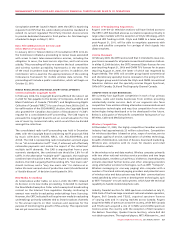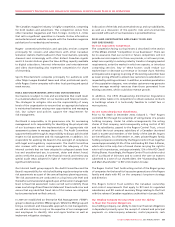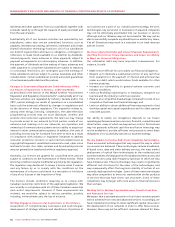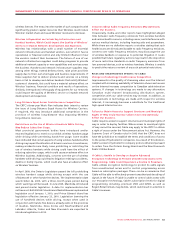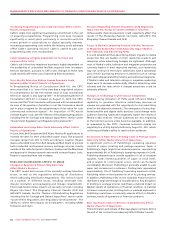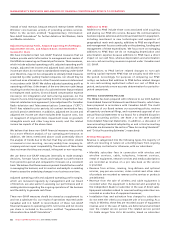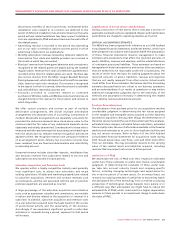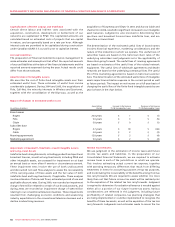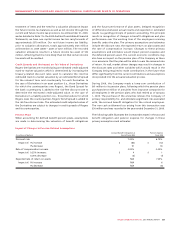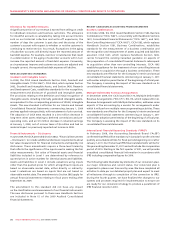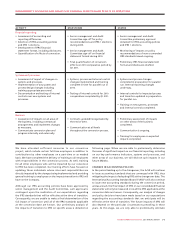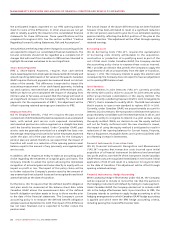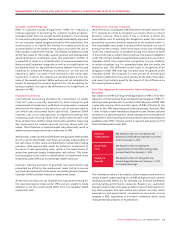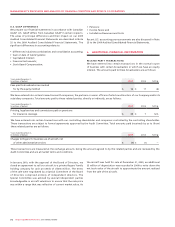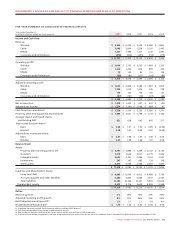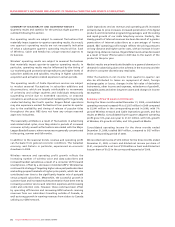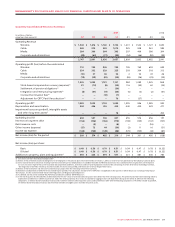Rogers 2009 Annual Report Download - page 63
Download and view the complete annual report
Please find page 63 of the 2009 Rogers annual report below. You can navigate through the pages in the report by either clicking on the pages listed below, or by using the keyword search tool below to find specific information within the annual report.
ROGERS COMMUNICATIONS INC. 2009 ANNUAL REPORT 67
MANAGEMENT’S DISCUSSION AND ANALYSIS OF FINANCIAL CONDITION AND RESULTS OF OPERATIONS
Capitalization of Direct Labour and Overhead
During construction of new assets, direct costs plus a portion of
applicable overhead costs are capitalized. Repairs and maintenance
expenditures are charged to operating expenses as incurred.
CRITICAL ACCOUNTING ESTIMATES
This MD&A has been prepared with reference to our 2009 Audited
Consolidated Financial Statements and Notes thereto, which have
been prepared in accordance with Canadian GAAP. The preparation
of these financial statements requires management to make
estimates and assumptions that affect the reported amounts of
assets, liabilities, revenues and expenses, and the related disclosure
of contingent assets and liabilities. These estimates are based on
management’s historical experience and various other assumptions
that are believed to be reasonable under the circumstances, the
results of which form the basis for making judgments about the
reported amounts of assets, liabilities, revenue and expenses
that are not readily apparent from other sources. Actual results
could differ from those estimates. We believe that the accounting
estimates discussed below are critical to our business operations
and an understanding of our results of operations or may involve
additional management judgment due to the sensitivity of the
methods and assumptions necessary in determining the related
asset, liability, revenue and expense amounts.
Purchase Price Allocations
The allocations of the purchase prices for our acquisitions involves
considerable judgment in determining the fair values assigned
to the tangible and intangible assets acquired and the liabilities
assumed on acquisition. Among other things, the determination of
these fair values involved the use of discounted cash flow analyses,
estimated future margins, estimated future subscribers, estimated
future royalty rates, the use of information available in the financial
markets and estimates as to costs to close duplicate facilities and
buy out certain contracts. Refer to Note 4 of the 2009 Audited
Consolidated Financial Statements for acquisitions made during
2009. Should actual rates, cash flows, costs and other items differ
from our estimates, this may necessitate revisions to the carrying
value of the related assets and liabilities acquired, including
revisions that may impact net income in future periods.
Useful Lives of PP&E
We depreciate the cost of PP&E over their respective estimated
useful lives. These estimates of useful lives involve considerable
judgment. In determining the estimates of these useful lives,
we take into account industry trends and company-specific
factors, including changing technologies and expectations for
the in-service period of certain assets. On an annual basis, we
re-assess our existing estimates of useful lives to ensure they match
the anticipated life of the technology from a revenue-producing
perspective. If technological change happens more quickly or in
a different way than anticipated, we might have to reduce the
estimated life of PP&E, which could result in a higher depreciation
expense in future periods or an impairment charge to write down
the value of PP&E.
disconnects, transfers of service and moves. Incremental direct
installation costs related to re-connects are deferred to the
extent of deferred installation fees and amortized over the same
period as these related installation fees. New connect installation
costs are capitalized to PP&E and amortized over the useful life of
the related assets;
• Advertising revenueisrecorded intheperiodtheadvertising
airs on our radio or television stations and the period in which
advertising is featured in our publications;
• Monthlysubscriptionrevenuesreceivedbytelevisionstationsfor
subscriptions from cable and satellite providers are recorded in
the month in which they are earned;
• BlueJays’revenuefromhomegameadmissionandconcessionsis
recognized as the related games are played during the baseball
regular season. Revenue from radio and television agreements is
recorded at the time the related games are aired. The Blue Jays
also receive revenue from the Major League Baseball Revenue
Sharing Agreement, which distributes funds to and from member
clubs, based on each club’s revenues. This revenue is recognized
in the season in which it is earned, when the amount is estimable
and collectibility is reasonably assured; and
• Discounts provided to customers related to combined
purchases of Wireless, Cable, and Media products and services are
charged directly to the revenue for the products and services to
which they relate.
We offer certain products and services as part of multiple
deliverable arrangements. We divide multiple deliverable
arrangements into separate units of accounting. Components of
multiple deliverable arrangements are separately accounted for
provided the delivered elements have stand-alone value to the
customers and the fair value of any undelivered elements can be
objectively and reliably determined. Consideration for these units is
measured and allocated amongst the accounting units based upon
their fair values and our relevant revenue recognition policies are
applied to them. We recognize revenue once persuasive evidence
of an arrangement exists, delivery has occurred or services have
been rendered, fees are fixed and determinable and collectibility
is reasonably assured.
Unearned revenue includes subscriber deposits, installation fees
and amounts received from subscribers related to services and
subscriptions to be provided in future periods.
Subscriber Acquisition and Retention Costs
We operate within a highly-competitive industry and generally
incur significant costs to attract new subscribers and retain
existing subscribers. All sales and marketing expenditures related
to subscriber acquisitions, retention and contract renewals, such
as commissions, and the cost associated with the sale of customer
premises equipment, are expensed as incurred.
A large percentage of the subscriber acquisition and retention
costs, such as equipment subsidies and commissions, are variable
in nature and directly related to the acquisition or renewal of a
subscriber. In addition, subscriber acquisition and retention costs
on a per-subscriber-acquired basis fluctuate based on the success
of promotional activity and the seasonality of the business.
Accordingly, if we experience significant growth in subscriber
activations or renewals during a period, expenses for that period
will increase.


